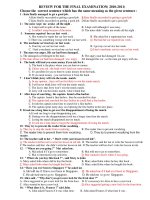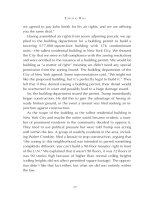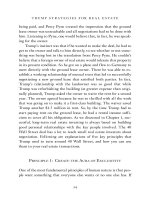Options trading for the conservative investor (2010)
Bạn đang xem bản rút gọn của tài liệu. Xem và tải ngay bản đầy đủ của tài liệu tại đây (1.48 MB, 271 trang )
Download at WoweBook.Com
OPTIONS
TRADING FOR THE
CONSERVATIVE
INVESTOR
From the Library of Lee Bogdanoff
Download at WoweBook.Com
This page intentionally left blank
From the Library of Lee Bogdanoff
Download at WoweBook.Com
OPTIONS
TRADING FOR THE
CONSERVATIVE
INVESTOR
INCREASING PROFITS
WITHOUT INCREASING
YOUR RISK
Michael C. Thomsett
From the Library of Lee Bogdanoff
Download at WoweBook.Com
Vice President, Publisher: Tim Moore
Associate Publisher and Director of Marketing: Amy Neidlinger
Executive Editor: Jim Boyd
Editorial Assistant: Pamela Boland
Operations Manager: Gina Kanouse
Senior Marketing Manager: Julie Phifer
Publicity Manager: Laura Czaja
Assistant Marketing Manager: Megan Colvin
Cover Designer: Alan Clements
Managing Editor: Kristy Hart
Project Editors: Julie Anderson and Jovana San Nicolas-Shirley
Copy Editor: Karen Gill
Proofreader: Dan Knott
Indexer: Michael C. Thomsett
Senior Compositor: Gloria Schurick
Manufacturing Buyer: Dan Uhrig
2010 by Pearson Education, Inc.
Publishing as FT Press
Upper Saddle River, New Jersey 07458
This book is sold with the understanding that neither the author nor the publisher is engaged
in rendering legal, accounting, or other professional services or advice by publishing this
book. Each individual situation is unique. Thus, if legal or financial advice or other expert
assistance is required in a specific situation, the services of a competent professional should
be sought to ensure that the situation has been evaluated carefully and appropriately. The
author and the publisher disclaim any liability, loss, or risk resulting directly or indirectly,
from the use or application of any of the contents of this book.
FT Press offers excellent discounts on this book when ordered in quantity for bulk purchases
or special sales. For more information, please contact U.S. Corporate and Government Sales,
1-800-382-3419, For sales outside the U.S., please contact
International Sales at
Company and product names mentioned herein are the trademarks or registered trademarks of
their respective owners.
All rights reserved. No part of this book may be reproduced, in any form or by any means,
without permission in writing from the publisher.
Printed in the United States of America
First Printing January 2010
ISBN-10: 0-13-704200-0
ISBN-13: 978-0-13-704200-5
Pearson Education LTD.
Pearson Education Australia PTY, Limited.
Pearson Education Singapore, Pte. Ltd.
Pearson Education North Asia, Ltd.
Pearson Education Canada, Ltd.
Pearson Educación de Mexico, S.A. de C.V.
Pearson Education—Japan
Pearson Education Malaysia, Pte. Ltd.
Library of Congress Cataloging-in-Publication Data
Thomsett, Michael C.
Options trading for the conservative investor : increasing profits without increasing your risk /
Michael C. Thomsett. — 2nd ed.
p. cm.
Includes bibliographical references and index.
ISBN 978-0-13-704200-5 (hardback : alk. paper) 1. Stock options. 2. Options (Finance) 3.
Investments. 4. Risk management. I. Title.
HG6042.T462 2010
332.63’2283—dc22
2009036159
From the Library of Lee Bogdanoff
Download at WoweBook.Com
CONTENTS
ACKNOWLEDGMENTS . . . . . . . . . . . .xi
ABOUT THE AUTHOR . . . . . . . . . . . .xii
PREFACE . . . . . . . . . . . . . . . . . . . . . . .xiii
CHAPTER 1: SETTING THE GROUND RULES . . . .1
The Ground Rules . . . . . . . . . . . . . . .2
A Model Portfolio . . . . . . . . . . . . . . .4
CHAPTER 2: OPTION BASICS . . . . . . . . . . . . . . . . . .7
The Workings of Option
Contracts . . . . . . . . . . . . . . . . . . . . .8
Long and Short . . . . . . . . . . . . . . . .13
Calls and Call Strategies . . . . . . . . .17
Puts and Put Strategies . . . . . . . . . .22
Listed Options and LEAPS
Options . . . . . . . . . . . . . . . . . . . . . .28
Coordinating Strategies with
Portfolio Goals . . . . . . . . . . . . . . . .32
Option and Stock Volatility:
The Central Element of Risk . . . .35
v
From the Library of Lee Bogdanoff
Download at WoweBook.Com
Trading Costs in the Option
Analysis . . . . . . . . . . . . . . . . . . . . . .46
Tax Rules for Options:
An Overview . . . . . . . . . . . . . . . . . .47
The Importance of Professional
Advice and Tax Planning . . . . . . . .48
CHAPTER 3: OPTIONS IN CONTEXT . . . . . . . . . . .51
The Nature of Risk and Reward . . .52
Perceptions about Options . . . . . . .60
Short Positions: Naked or
Covered . . . . . . . . . . . . . . . . . . . . . .63
Margin Requirements and
Trading Restrictions . . . . . . . . . . .68
Return Calculations: Seeking
Valid Comparisons . . . . . . . . . . . . .70
Long-Term Goals as a
Guiding Force . . . . . . . . . . . . . . . . .80
Exercise as a Desirable Outcome . .82
CHAPTER 4: MANAGING PROFITS
AND LOSSES . . . . . . . . . . . . . . . . . . . . .85
Your Conservative Dilemma . . . . . .87
Managing Profits with Options . . .89
Overcoming the Profit-Taking
Problem . . . . . . . . . . . . . . . . . . . . .92
vi
OPTIONS TRADING FOR THE CONSERVATIVE INVESTOR
From the Library of Lee Bogdanoff
Download at WoweBook.Com
Managing the Inertia Problem . . . .99
Taxes and Profits . . . . . . . . . . . . . .102
CHAPTER 5: OPTIONS AS CASH
GENERATORS . . . . . . . . . . . . . . . . . .107
The Covered Call Concept . . . . . .108
Examples: Ten Stocks and
Covered Calls . . . . . . . . . . . . . . . .110
Smart Conservative Ground
Rules . . . . . . . . . . . . . . . . . . . . . . .115
A Conservative Approach . . . . . . .121
Tax Ramifications of
Covered Calls . . . . . . . . . . . . . . . .125
Rolling Forward and Up:
Exercise Avoidance . . . . . . . . . . . .130
The Exercise Acceptance
Strategy . . . . . . . . . . . . . . . . . . . . .131
CHAPTER 6: ALTERNATIVES TO STOCK
PURCHASE . . . . . . . . . . . . . . . . . . . .133
Leverage and Options . . . . . . . . . .134
The Long-Call ContingentPurchase Strategy . . . . . . . . . . . . .137
The Covered Long Call . . . . . . . . .140
Short Puts and Contingent
Purchase . . . . . . . . . . . . . . . . . . . .144
Contents
vii
From the Library of Lee Bogdanoff
Download at WoweBook.Com
Rescue Strategy Using Calls . . . . .148
Rescue Strategy Using Puts . . . . . .154
Covered Calls for
Contingent Sale . . . . . . . . . . . . . .155
CHAPTER 7: OPTION STRATEGIES IN DOWN
MARKETS . . . . . . . . . . . . . . . . . . . . . .157
Thinking Outside the
Market Box . . . . . . . . . . . . . . . . . .158
The Long Put:
The Overlooked Option . . . . . . .161
Short Puts: A Variety of
Strategies . . . . . . . . . . . . . . . . . . . .165
Comparing Rates of Return for
Dissimilar Strike Prices . . . . . . . .170
Using Calls in Down Markets . . . .172
Evaluating Your Stock Positions . .175
Stock Positions and Risk
Evaluation . . . . . . . . . . . . . . . . . . .180
Options and Downside Risk . . . . .182
Option Planning with
Loss Carryover . . . . . . . . . . . . . . .185
CHAPTER 8: COMBINATION CONSERVATIVE
TECHNIQUES . . . . . . . . . . . . . . . . . .189
Spread Techniques . . . . . . . . . . . . .190
viii
OPTIONS TRADING FOR THE CONSERVATIVE INVESTOR
From the Library of Lee Bogdanoff
Download at WoweBook.Com
Straddle Techniques . . . . . . . . . . . .192
Long or Short Positions . . . . . . . . .194
Theory Versus Practice . . . . . . . . .196
Tax Problems with Combination
Strategies . . . . . . . . . . . . . . . . . . . .199
The Ultimate High-Return
Strategy . . . . . . . . . . . . . . . . . . . . .200
Examples of the Strategy in
Practice . . . . . . . . . . . . . . . . . . . . .202
Outcome Scenarios . . . . . . . . . . . .211
The Augmented Strategy:
A Short Straddle . . . . . . . . . . . . . .213
Rescue Strategies . . . . . . . . . . . . . .218
CHAPTER 9: STOCK SELECTION AND THE
OPTION CONTRACT . . . . . . . . . . .221
Remembering Your Conservative
Profile as a Priority . . . . . . . . . . . .223
Dangers and Pitfalls in Using
Options . . . . . . . . . . . . . . . . . . . . .224
Temptation to Select Most
Volatile Stocks . . . . . . . . . . . . . . .226
Creating Sensible Conservative
Standards . . . . . . . . . . . . . . . . . . .228
Maintaining Fundamental
Clarity . . . . . . . . . . . . . . . . . . . . . .232
Contents
ix
From the Library of Lee Bogdanoff
Download at WoweBook.Com
The Importance of Taxes in the
Option Equation . . . . . . . . . . . . .235
Option Volatility to
Judge Stocks . . . . . . . . . . . . . . . . .236
APPENDIX: OPTION TRADING STRATEGIES . .239
GLOSSARY . . . . . . . . . . . . . . . . . . . . .243
INDEX . . . . . . . . . . . . . . . . . . . . . . . . .249
x
OPTIONS TRADING FOR THE CONSERVATIVE INVESTOR
From the Library of Lee Bogdanoff
Download at WoweBook.Com
ACKNOWLEDGMENTS
M
any thanks to Michael Panzner, Rudy Morando, Harry Domash,
and Steve Kursh, all of whom added to this project with their
suggestions. Also, I am most grateful to my editor, Jim Boyd, for his
steady hand and guidance.
Acknowledgments
xi
From the Library of Lee Bogdanoff
Download at WoweBook.Com
ABOUT THE AUTHOR
Michael C. Thomsett has published more than 70 books on investing
and business topics, including Stock Profits: Getting to the Core (FT
Press, 2004) and many other books concerning options and stock market investing. His best-selling book Getting Started in Options (John
Wiley & Sons, 2009) is in its 8th edition and has sold more than
250,000 copies. He has written many other books published by John
Wiley & Sons, Amacom Books, and Dearborn. Thomsett lives in
Nashville, Tennessee.
xii
OPTIONS TRADING FOR THE CONSERVATIVE INVESTOR
From the Library of Lee Bogdanoff
Download at WoweBook.Com
PREFACE
The Elusive Goal: Low Risk and High Yield
T
here is good news about the market. Recent stock market trends
have been troubling for just about everyone invested in stocks. The
traditional approach of buy-and-hold and the trusted technique of
value investing based on a study of the fundamentals seemed to fall
apart beginning in 2008. Does this mean that buy-and-hold is dead?
Not at all. The cyclical nature of the market simply went through a
strong bear cycle, but the strength of the American stock market has
shown time and again that downward movements are temporary and
are always followed by record-breaking upward-moving markets.
In the meantime, however, you may have seen most of your retirement
savings and personal portfolio disappear. The staggering losses in even
the best-known value investments brought into question the basic
“safe” philosophy of the market. To protect yourself in this kind of
volatile and uncertain environment, you need strategies to hedge losses; create extra sources of income; and most of all, reduce risk while
increasing net yield.
Is it even possible to match low risk with high yield in the volatile markets that have dominated recent years? Most experts question the idea
that risk-averse investors can outperform the market averages.
However, this book challenges the conventional wisdom by demonstrating how conservative investors can exploit a narrow band of potential strategies, dramatically increase yields, and, at the same time,
manage risks within their self-defined risk limitations.
To some conservative investors, options are too exotic and too risky. If
a range of strategies is too much trouble or contains too many pitfalls,
it is not worth pursuing. But a basic premise in this book is that a conservative investor is not necessarily someone who does not want to
expand beyond a well-understood and short list of investment possibilities. Being a conservative investor does not necessarily mean that you
Preface
xiii
From the Library of Lee Bogdanoff
Download at WoweBook.Com
are unwilling to examine new ideas, expand your portfolio, or take
acceptable risks. It just means that you are not interested in speculation
or in exposing yourself to the possibilities of high risk.
Investors tend to be aware of the potential for high returns without also
acknowledging that such strategies are usually accompanied by
unavoidable high risks. This is where the inexperienced suffer losses in
the market. The lack of experience that attracts the novice to speculation in options and other high-risk strategies has caused much grief in
the market. When you look back at the dot-com years, you see that
many first-time investors made quick paper profits, only to lose it all in
a sudden reversal of fortunes. But conservative investors know that putting all capital in a single industry is ill advised, especially if companies
are chosen that have never reported a net profit, whose stock has risen
more than $200 per share in a few months, or whose actual core business is only vaguely defined.
Given these observations, conservative investors naturally seek methods for using their capital that achieve some specific goals, including
the following:
■
■
■
Preserving spending power after both inflation and taxes
Avoiding unacceptable market, liquidity, and diversification
risks
Protecting profits without loss of invested positions, hedging the
portfolio against the possibility of loss
These goals are typical for conservative investors and actually serve
moderate investors just as well. They involve strategies for avoiding
loss. As a conservative investor, you are not averse to risk in any and
every form; essentially, you are averse to unexpected surprises. This is
perhaps the most important distinguishing characteristic between you
and other investors. The majority of novice investors are surprised
when they lose money in the market, but, in retrospect, should they
have been surprised? In most situations, novices operate on certain
assumptions concerning potential profits but are unaware of the related risk or the degree of risk exposure. Otherwise, their investment decisions probably would have been different.
xiv
OPTIONS TRADING FOR THE CONSERVATIVE INVESTOR
From the Library of Lee Bogdanoff
Download at WoweBook.Com
With this in mind, this book offers a more realistic definition of conservative investors: those who are experienced enough to be aware of both
yield and risk and who make decisions based on that level of awareness.
Conservative investors are not as likely as other investors to be taken by
surprise when they lose money in the market. Another aspect of this
expanded definition distinguishes between risk profile and the willingness to use creative and alternative strategies. Conservative investors are
not close-minded and do not reject exotic instruments like options
merely because of their reputation as high-risk. Instead, well-informed
conservative investors are likely to examine claims about high-yield
potential with an open mind. You may be skeptical and, at the same
time, willing to listen to the suggestion that the combination is at least
possible. A limited number of strategies do, in fact, offer the potential
for various conservative applications to meet the three goals common
to conservative investors: preserving capital, avoiding unacceptable
risk, and protecting paper profits. For example, this book includes
12 overall strategies (see the Appendix, “Option Trading Strategies”),
qualified in terms of risk levels.
This book does not suggest that you have to become an expert in a
broad range of complex or exotic options strategies. Instead, it proposes a rather limited number of strategies appropriate for conservative
investors. This approach respects the risk limitations in the conservative strategy while showing how experienced stock market investors can
expand their yield levels significantly, protect existing positions, and
come through market down cycles intact.
Preface
xv
From the Library of Lee Bogdanoff
Download at WoweBook.Com
This page intentionally left blank
From the Library of Lee Bogdanoff
Download at WoweBook.Com
1
SETTING THE GROUND
RULES
In any discussion of an investment strategy, you begin with a
series of assumptions. Your assumptions tie in to your
conservative profile: You have prequalified the stock of a limited
number of companies; you believe these stocks will rise in value
over time; fundamentals are essential in stock selection; you
would be happy to buy more shares; and a finite number of
companies meet your standards. We have identified ten
companies that make up a “model portfolio” to illustrate the
options strategies in this book. These serve as examples of
companies meeting a few basic criteria for picking companies
and their stocks, as candidates for conservative options trading.
1
From the Library of Lee Bogdanoff
Download at WoweBook.Com
T
his book explains how conservative investors can employ options
strategies to (a) enhance current income without increasing
market risks; (b) protect long positions through options used for
insurance; and (c) create a form of contingency to survive in volatile
market conditions.
The Ground Rules
Because you are a conservative investor, the arguments in this book are
based on a series of underlying assumptions. Always keep these ground
rules in mind, because they relate to your risk profile and to your investing philosophy. Five underlying assumptions are used in this book.
1. You will limit options activities to stocks you have prequalified.
This is a necessary starting point as long as your portfolio—and
the stocks you use for options strategies—includes stocks you
believe in as long-term-hold stocks, and you consider these
stocks permanent parts of your portfolio (as long as the fundamentals remain strong). This is an important attribute because
it is not conservative to buy stocks solely to use for options
strategies. A conservative approach to options must include the
premise that your activities will be limited to the strongest possible stocks you can find.
2. You believe that your stocks will rise in value. A conservative
investor naturally expects stocks to rise in value; otherwise, why
keep them? But this seemingly obvious point has relevance in
the underlying assumptions of this book. Many of the discussions of strategies are premised on a belief that over the long
term, the subject stock’s market value will rise. Many options
strategies work best when stocks do not rise, so for example,
covered call writing (a very conservative strategy) is most profitable when stock values remain steady or even fall slightly. This
2
OPTIONS TRADING FOR THE CONSERVATIVE INVESTOR
From the Library of Lee Bogdanoff
Download at WoweBook.Com
means that you may need to time a strategy to produce profits
resulting from short-term stability in prices, hoping for longerterm growth. So a second underlying assumption is in line with
the conservative approach. This means you want to accumulate
shares of value investments; you expect prices to rise over time;
and you will change a hold to a sell when the fundamentals
change. However, at the same time, some options strategies are
designed to take advantage of short-term price volatility. When
marketwide volatility affects short-term prices in your stocks,
you have an opportunity to pick up discounted shares, take
profits (without having to sell stock), or average down your
overall basis. Of course, the proposal that you should average
down is conservative only if the basic stock selection assumptions remain valid. You will want to employ such a strategy
only for stocks in which you have a strong belief as long-term
value investments.
3. You accept the premise that fundamental analysis of stocks is
an essential first step in the process of examining option
opportunities. Options have no fundamental attributes. These
are intangible contractual instruments, and they have no value
on their own; thus, you can only judge the tangible value of
stock as a means for selecting appropriate options strategies.
Many first-time options traders make the mistake of overlooking this basic reality. They select options (and stocks) based on
the immediate return potential, but they ignore the real market
risks of the underlying stocks. This violates the conservative
tenet that stocks should be chosen for their fundamental
strength and growth potential.
4. In the event of a temporary downward movement in a stock’s
price, you would be happy to buy more shares. Some investors
may be unwilling to pick up more shares of a particular stock,
even when the opportunity to buy discounted shares is presented. In this book, several strategies are introduced proposing
that additional shares may be purchased (or exposed to contingent purchase) using options. If this is not the case in a particular situation, those suggestions should be passed over. You may
have a strict formula for diversification or asset allocation that
Chapter 1 Setting the Ground Rules
3
From the Library of Lee Bogdanoff
Download at WoweBook.Com
you use to limit risks in any particular stocks, for example, so
strategies aimed at increasing your holdings in one stock may
contradict your portfolio management standards in such an
instance. Strategies proposing that you set up situations in
which more shares may be picked up work only if that suggestion conforms to your overall portfolio plan.
5. You believe that an adequate number of available stocks meet
your criteria. Some investors become convinced that their
short list of stocks is the only list available to them. Thus, if
they were to sell shares of stock from their portfolio, they
would be unable to reinvest profits in equally acceptable stocks.
If you do not believe this, you are probably aware that dozens
of stocks meet your fundamental criteria, in terms of price
level, PE ratio, volatility, dividend payment history, and a range
of other analytical tests. Accordingly, if a particular stock is sold
from your portfolio, a number of other stocks that you could
and would purchase upon sale of stocks you currently own also
conform to your criteria.
Incidentally, this practice makes sense whether you trade options or
not. The fundamentals can change for any company, so if a hold stock
changes to a sell, you need to reinvest funds. As a matter of basic portfolio management, every investor needs a secondary list of stocks that
would be used to replace sold stocks from the current portfolio. The
need for maintaining this list relates to options trading because some
strategies result in selling shares of stock. In those cases, you want to
reinvest capital in a new issue on your list of qualified stocks.
A Model Portfolio
In the examples used in the following chapters, these five underlying
assumptions demonstrate how options work within the conservative
framework. These criteria are applied to a model portfolio of ten
stocks, which are used in various combinations throughout. This helps
to tie together the various examples and range of possible outcomes.
This model portfolio is by no means a recommendation of stocks you
should own. It was selected to include stocks with some common
4
OPTIONS TRADING FOR THE CONSERVATIVE INVESTOR
From the Library of Lee Bogdanoff
Download at WoweBook.Com
attributes. Many have increased dividends every year for the past ten
years and reported low volatility in trading. Others have exhibited rising market value in recent years. All these stocks have available both
listed options and long-term options (LEAPS), enabling you to look at
a variety of scenarios for each conservative strategy.
Employing a single portfolio throughout the book is helpful in another
way. Not every strategy works well for each stock in the model portfolio, so you can walk through the selection process to demonstrate how
a particular strategic decision is made. Although your portfolio may
contain a number of excellent value investments, some strategies simply do not work at all times or in all cases. You can compare the different potentials for strategies across a range of stocks by following the
model portfolio throughout the explanations in each chapter.
The values of each stock, current bid, and asked value of every option
used in this book are based on the closing prices reported by the
Chicago Board of Exchange (CBOE) on April 18, 2009. Table 1-1 summarizes this model portfolio.
Table 1-1 Model Portfolio
Stock Name
Trading Symbol
Closing Price *
Caterpillar
CAT
32.29
IBM
IBM
101.27
Johnson & Johnson
JNJ
53.05
Coca-Cola
KO
45.02
McDonald’s
MCD
56.09
3M
MMM
53.81
Altria
MO
16.99
United Parcel Service
UPS
54.65
Wal-Mart
WMT
50.20
Exxon Mobil
XOM
66.75
* Closing prices as of April 18, 2009
Chapter 1 Setting the Ground Rules
5
From the Library of Lee Bogdanoff
Download at WoweBook.Com
Is this a “conservative” portfolio? That is a matter of opinion—and one
that depends on the timing of purchase, long-term goals, and your personal opinion about the fundamentals for each corporation. These ten
stocks provide a cross section of stocks that illustrate where strategies
work well and where they do not work at all. The actual definition of a
conservative portfolio is (and should be) always evolving based on
changes in the market, in a stock’s market price and volatility, and, of
course, in emerging information concerning fundamental strength or
weakness of a particular company.
Is this information out of date? The data gathered on the closing date—
April 18, 2009—is old, but it would be impossible to perpetually update
10 stocks and still meet the publication date of this book. However, all
the information is relative. The values of options for a particular stock
will probably be consistent from one period to the next—assuming the
proximity between closing price and option strike price is about the
same, and that months to go until expiration are the same as well.
Although these relationships can and do vary based on ever-changing
perceptions about a particular company, the data is valid for the purpose of illustrating strategies. The use of some measurement in time is
necessary, and all these stocks were selected and summarized on the
same date. Given all these qualifications, these closing prices (and the
option values used in this book) are fair and reasonable. As of that same
date, April 18, 2009, there were about 2,500 stocks that had options
available to trade—a lot of choices for conservative investors.
6
OPTIONS TRADING FOR THE CONSERVATIVE INVESTOR
From the Library of Lee Bogdanoff
Download at WoweBook.Com
2
OPTION BASICS
The biggest hurdle in the options market is terminology. This
chapter explains the basic concepts and defines option terms;
introduces call and put strategies; explains how long and short
positions work in both types of option contracts; and provides
an overview of the options market.
7
From the Library of Lee Bogdanoff
Download at WoweBook.Com
T
ypically, books about options start by showing how you can leverage a small amount of capital to make fantastic profits, often in the
triple digits. Such books tend to quickly become overly technical
and complex, so that you end up with two problems. First, you are
exposed to the proposition that you can get rich by speculating in
options; second, the discussion becomes obscure as the details emerge.
This is not an approach that works for conservative investors. One basic
assumption in this book is that, as a conservative investor, you want to
know exactly how options might or might not work in your portfolio,
and you want the information to be presented clearly and logically.
Because this involves a fairly narrow range of possible strategies—only
those appropriate in a conservative portfolio—a lot of the more exotic
potential of options is avoided.
Even the most experienced investor struggles with terminology and the
meaning of key concepts, so this chapter covers the important matters
that you need to master, including explanations of calls and puts in either
long or short positions; how option contracts work; expiration of
options; strike prices; and time, extrinsic, and intrinsic value. In discussing the range of possible strategies, the purpose is not to recommend any particular approach but to explore and review all the
possibilities. As a conservative investor, you will find only a small portion
of these strategies to be of interest; but you can also benefit from knowing about all the potential uses of calls and puts.
The Workings of Option Contracts
In this section, you find a review of the option contract rules. The
mechanics of expiration, strike price, and time, extrinsic, and intrinsic
value affect all decisions related to how you should or should not employ
8
OPTIONS TRADING FOR THE CONSERVATIVE INVESTOR
From the Library of Lee Bogdanoff









